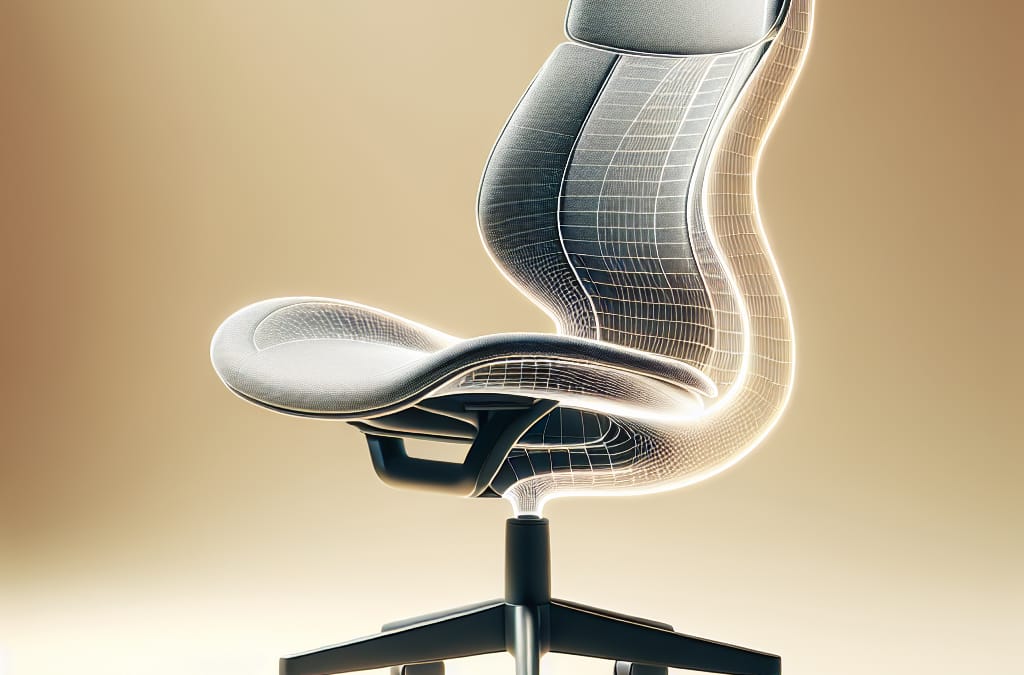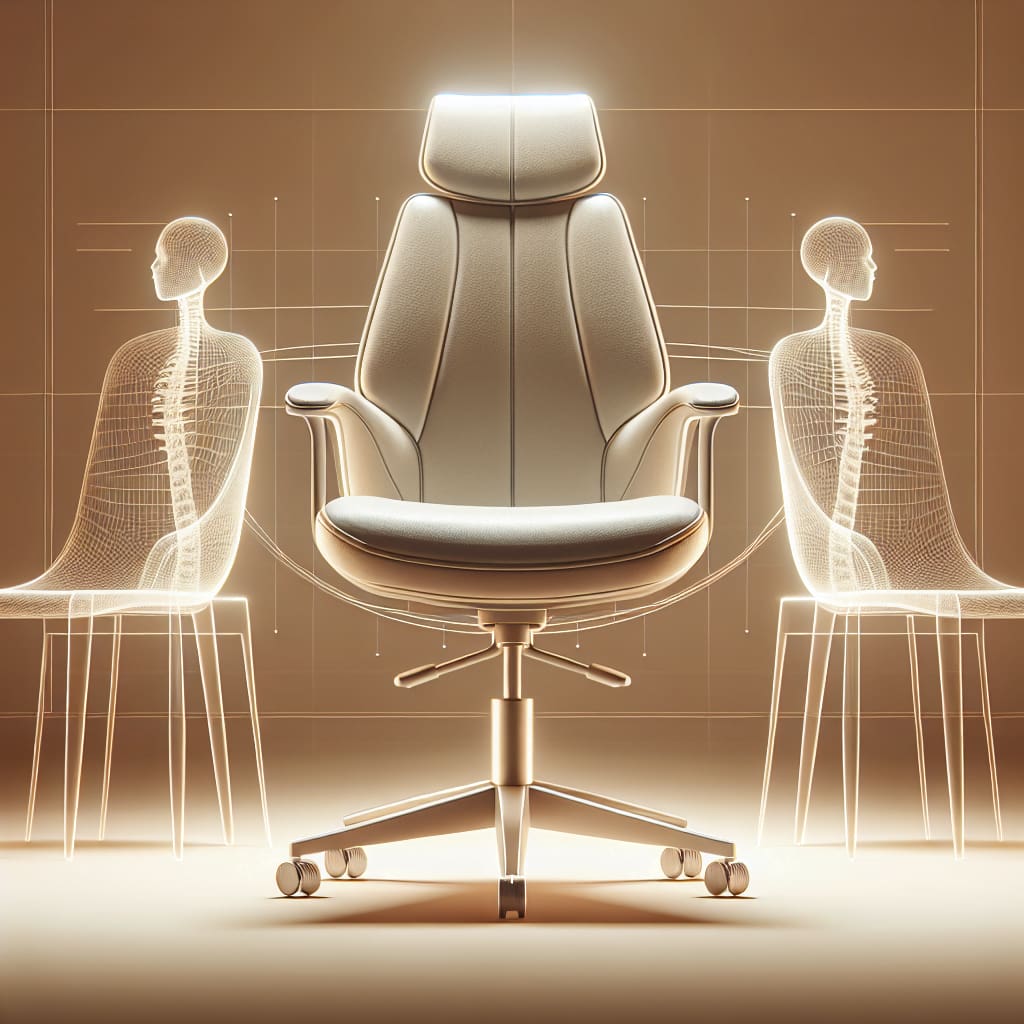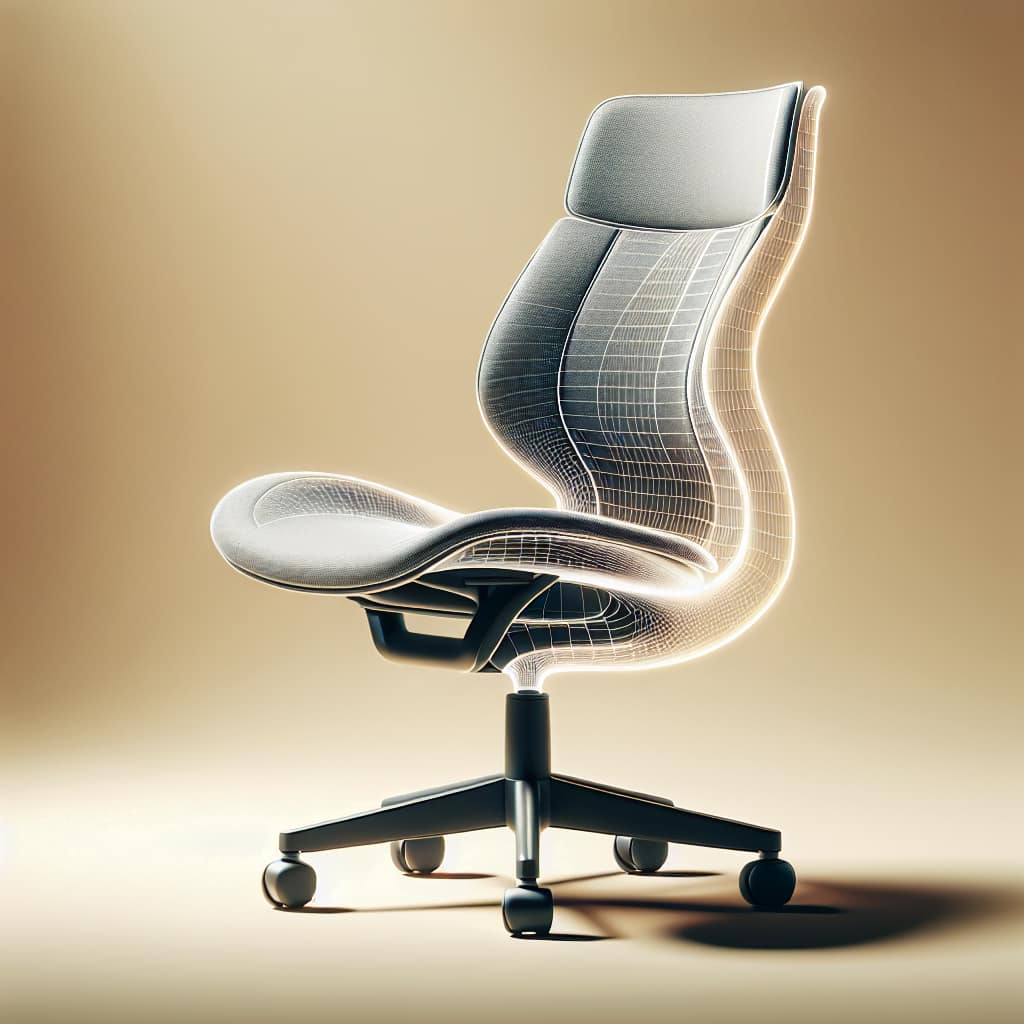In her insightful articles on home office design and ergonomic setups, Emily Carter explores the numerous ways in which an ergonomic chair can improve posture. Drawing on her decade-long expertise in the field, Emily emphasizes the importance of ergonomics in creating functional and comfortable work environments. With a friendly and conversational writing style, she provides practical tips, step-by-step guides, and personalized advice for readers seeking to enhance their home office setups. Through high-quality visuals and interactive elements, Emily engages her audience and encourages them to actively participate in the discussion. For anyone looking to create an efficient and comfortable workspace at home, Emily Carter’s articles are a valuable resource.

Understanding Ergonomics and Posture
Definition of ergonomics
Ergonomics is the study of how humans interact with their environment, specifically focusing on designing products and systems that optimize human performance and well-being. In the context of office furniture, ergonomics involves creating chairs and workstations that support proper posture and minimize the risk of musculoskeletal disorders.
The importance of good posture
Maintaining good posture while sitting is vital for our overall well-being. When we adopt a slouched position or hunch over, it can lead to back, neck, and shoulder pain, as well as fatigue and reduced productivity. Good posture, on the other hand, allows our body to align naturally, reducing strain on our muscles, joints, and ligaments.
Relation between ergonomics and posture
Ergonomics and posture are closely intertwined. Ergonomic principles guide the design of chairs and other office furniture to promote good posture. By incorporating ergonomic features, such as adjustable seat height, lumbar support, and armrests, chairs can help individuals maintain a neutral spinal alignment and avoid poor posture habits. Understanding the connection between ergonomics and posture is essential for creating a comfortable and healthy work environment.
The Role of Ergonomic Chairs in Improving Posture
How the design of an ergonomic chair supports good posture
ergonomic chairs are specifically designed to support and promote good posture. They typically have adjustable features that allow users to customize the chair to their body’s unique needs. For example, ergonomic chairs often have adjustable seat height, allowing users to position their feet flat on the ground and maintain a 90-degree angle at the knees and hips. This helps distribute weight evenly and reduces pressure on the lower back.
Features of ergonomic chairs that differentiate them from regular chairs
Ergonomic chairs have several features that set them apart from regular chairs. These features include lumbar support, Adjustable armrests, headrests, mesh backrests, tilt mechanisms, swivel capabilities, and even footrest options. Each of these features plays a role in supporting proper posture and reducing strain on the body. Regular chairs, on the other hand, often lack these adjustable features and may not provide adequate support for long hours of sitting.
The science behind ergonomic chairs and improved posture
The design of ergonomic chairs is based on scientific principles and research. Experts in the field of human factors and ergonomics conduct studies to determine the most effective ways to support the body and reduce the risk of musculoskeletal disorders. By incorporating these findings into the design of chairs, ergonomic furniture manufacturers can create products that improve posture and comfort. The science behind ergonomic chairs ensures that they are not just aesthetically pleasing, but also functional and beneficial for our overall well-being.
Identifying Suitable Ergonomic Chairs for Different Body Types
Ergonomic chairs for tall people
Tall individuals often struggle to find chairs that accommodate their height comfortably. Ergonomic chairs for tall people are designed with extended seat heights and adjustable features to ensure proper alignment and support. These chairs often have taller backrests, longer seat pans, and adjustable headrests to provide optimal comfort for taller users.
Ergonomic chairs for short people
Shorter individuals may find it challenging to find chairs that provide adequate support for their smaller frame. Ergonomic chairs for short people have adjustable features that allow the user to customize the chair to their specific needs. These chairs often have shorter seat pans and adjustable armrests to ensure a comfortable fit for shorter individuals.
Ergonomic chairs for heavy people
Heavy individuals require chairs that can accommodate their weight without sacrificing comfort or support. Ergonomic chairs for heavy people are designed with reinforced frames, wider seat pans, and sturdy materials to provide stability and durability. These chairs often have higher weight capacities and ample padding to ensure a comfortable sitting experience for heavier users.
Strategically Designed Features of Ergonomic Chairs
Ergonomic chairs with lumbar support
Lumbar support is a critical feature in ergonomic chairs that helps maintain the natural curvature of the spine. This support is located in the lower back area of the chair and can be adjusted to provide optimal comfort and support for each individual. By supporting the lumbar region, these chairs promote proper posture and alleviate lower back pain.
Ergonomic chairs with adjustable armrests
Adjustable armrests allow users to position their arms and shoulders comfortably while working. These armrests can be adjusted in height and width, ensuring that the user’s forearms are parallel to the ground and their shoulders are relaxed. By providing proper arm support, ergonomic chairs with adjustable armrests prevent strain in the neck, shoulders, and upper back.
Ergonomic chairs with headrests
Headrests are a valuable feature in ergonomic chairs, especially for individuals who spend long hours at a desk. A headrest provides support for the neck and head, reducing tension and promoting proper alignment. Ergonomic chairs with headrests allow users to rest and relax their neck muscles, preventing stiffness and discomfort.
Ergonomic chairs with mesh backrest
Mesh backrests offer excellent breathability and comfort, making them a popular choice in ergonomic chairs. The mesh material allows air to circulate, preventing the build-up of heat and moisture. Additionally, mesh backrests provide flexible support, conforming to the contours of the user’s back and promoting good posture.
Ergonomic chairs with tilt mechanism
A tilt mechanism in an ergonomic chair enables the user to recline and lean back comfortably. This feature allows for dynamic movement, reducing the risk of static sitting and promoting blood circulation. By incorporating a tilt mechanism, ergonomic chairs encourage natural movement and prevent stiffness and discomfort.
Ergonomic chairs with swivel
Swivel capabilities in ergonomic chairs allow users to rotate the chair without straining their body. This feature enables easy access to different areas of the workspace, minimizing the need for repetitive reaching or twisting movements. Ergonomic chairs with swivel enhance productivity by facilitating smooth and efficient movement.
Ergonomic chairs with footrest options
Footrest options in ergonomic chairs are beneficial for individuals who need additional support for their legs and feet. Adjustable footrests can be positioned to provide a comfortable elevation, reducing pressure on the legs and promoting circulation. By supporting the lower extremities, ergonomic chairs with footrest options improve overall comfort and reduce the risk of conditions such as swollen feet or varicose veins.
Exploring the Range of Ergonomic Chairs
High-back ergonomic office chairs
High-back ergonomic office chairs offer comprehensive support for the entire back, including the upper back and shoulders. These chairs often come with adjustable features, such as lumbar support and headrests, to ensure proper alignment and comfort. High-back ergonomic chairs are particularly beneficial for individuals who spend long hours sitting at a desk and require maximum support.
Compact ergonomic chairs for small spaces
For individuals with limited space in their home office, compact ergonomic chairs are an ideal choice. These chairs are designed to provide the same level of comfort and support as larger ergonomic chairs but in a more space-efficient design. Compact ergonomic chairs often have adjustable features and a smaller footprint, making them a practical solution for small home office setups.
Ergonomic kneeling chairs for home office
Ergonomic kneeling chairs offer an alternative sitting position that promotes proper spinal alignment and engages the core muscles. These chairs have a unique design with a sloping seat and knee rests, encouraging an upright posture. Ergonomic kneeling chairs help distribute weight more evenly, relieving pressure on the lower back and reducing the risk of discomfort or pain.
Heavy-duty ergonomic chairs for extra support
Heavy-duty ergonomic chairs are specifically designed to accommodate individuals with higher weight capacities. These chairs have sturdy frames and reinforced components to ensure stability and durability. Heavy-duty ergonomic chairs provide the same level of comfort and support as standard ergonomic chairs but with the added assurance of being able to withstand more substantial loads.
Mesh back ergonomic office chairs
Mesh back ergonomic office chairs offer excellent breathability and comfort due to their mesh material. These chairs allow air to flow freely, preventing heat build-up and maintaining a comfortable temperature. Mesh back ergonomic chairs are ideal for individuals who tend to feel overheated while sitting for extended periods.
Ergonomic chairs with modern aesthetics
Ergonomic chairs with modern aesthetics combine both style and functionality. These chairs feature sleek designs, clean lines, and contemporary finishes, making them a perfect fit for modern home office spaces. While they prioritize visual appeal, these chairs do not compromise on comfort or ergonomic features, ensuring optimal support for the user.
Designer ergonomic office chairs
Designer ergonomic office chairs are for those who appreciate the fusion of artistry and functionality. These chairs are often created by renowned designers and feature unique shapes, premium materials, and innovative designs. Designer ergonomic chairs provide a luxurious and visually striking seating option while still prioritizing ergonomic principles and ensuring optimal comfort.
Special Ergonomic Chairs for Specific User Needs
Ergonomic chairs for pregnant women
Pregnancy can put a strain on the body, especially the lower back and pelvis. Ergonomic chairs for pregnant women are designed to provide additional support and comfort for expectant mothers. These chairs often have adjustable lumbar support, wider seat pans, and extra padding for optimal comfort and safety during pregnancy.
Ergonomic chairs for seniors
As individuals age, they may require additional support for their joints and muscles. Ergonomic chairs for seniors are designed with features that accommodate the specific needs of older individuals. These chairs typically have ample padding, adjustable features, and enhanced stability to provide maximum support and comfort for seniors.
Ergonomic chairs for people with back pain
Individuals who suffer from back pain can benefit greatly from ergonomic chairs that provide targeted support. ergonomic chairs for people with back pain often have adjustable lumbar support, allowing users to find the optimal position for their specific condition. These chairs help alleviate discomfort and promote a healthy sitting posture, reducing the risk of exacerbating back pain.
Ergonomic chairs for people with neck pain
Neck pain can be debilitating and significantly impact daily activities. Ergonomic chairs for people with neck pain offer additional support for the neck and head, reducing strain on the cervical spine. These chairs often have adjustable headrests and neck support, allowing users to position their head and neck in a comfortable and neutral alignment.
Ergonomic chairs for people with sciatica
Sciatica is a painful condition caused by compression or irritation of the sciatic nerve. Ergonomic chairs for people with sciatica are designed to alleviate pressure on the lower back and hips, reducing sciatic pain. These chairs often have adjustable lumbar support and seat pan depth, providing customized comfort and support for individuals with sciatica.
Ergonomic chairs for people with scoliosis
Scoliosis is a condition characterized by an abnormal curvature of the spine. Ergonomic chairs for people with scoliosis are designed to accommodate the unique spinal contours associated with this condition. These chairs often provide adjustable lumbar support and individualized adjustments to ensure proper spinal alignment and support for individuals with scoliosis.
Ergonomic chairs for people with herniated discs
Herniated discs can cause significant pain and discomfort, particularly in the lower back. Ergonomic chairs for people with herniated discs prioritize lumbar support, allowing users to adjust the chair’s curvature to provide optimal relief and support for the affected area. These chairs help reduce pressure on the discs and promote proper spinal alignment.
Choosing the Right Ergonomic Chair for Your Home Office
Factors to consider when buying an ergonomic chair
When purchasing an ergonomic chair for your home office, there are several factors to consider. These include the chair’s adjustability, lumbar support, seat depth, armrest adjustability, material, and overall comfort. It is essential to find a chair that can be customized to your body’s unique needs and provides adequate support for long hours of sitting.
Why material matters in ergonomic chairs
The material of an ergonomic chair can greatly impact its comfort and durability. Common materials used in ergonomic chairs include mesh, fabric, leather, and faux leather. Each material has its benefits and considerations, such as breathability, softness, cleaning ease, and longevity. It is crucial to choose a material that suits your preferences and aligns with your specific requirements for comfort and maintenance.
Adjusting your ergonomic chair for optimum comfort and support
To reap the full benefits of an ergonomic chair, it is essential to adjust it properly for your body. This may include adjusting the seat height, lumbar support, armrests, and other customizable features to ensure proper alignment and support. Following the manufacturer’s instructions or referring to an ergonomic chair setup and adjustment guide can help you optimize the chair’s comfort and support.
Ergonomic chair setup and adjustment guide
An ergonomic chair setup and adjustment guide provides step-by-step instructions on how to adjust your chair for optimal comfort and support. It typically includes guidelines for adjusting the seat height, lumbar support, armrests, headrests, and other customizable features. By following a comprehensive guide, you can ensure that your ergonomic chair is properly set up to promote good posture and reduce the risk of discomfort or injury.
Effects of Using Ergonomic Chairs over Time
Long-term benefits of using ergonomic chairs
Using ergonomic chairs consistently over time offers numerous long-term benefits. These benefits include improved posture, reduced risk of musculoskeletal disorders, increased comfort, enhanced productivity, and overall well-being. By investing in an ergonomic chair and prioritizing good posture, you can minimize the negative effects of prolonged sitting and enjoy the positive impact on your health and quality of life.
Overcoming health issues with the help of ergonomic chairs
Ergonomic chairs play a significant role in helping individuals overcome or manage various health issues related to poor posture and prolonged sitting. By providing proper support and promoting good posture, ergonomic chairs can help alleviate back pain, neck pain, shoulder strain, and other musculoskeletal discomfort. They can also prevent the onset or progression of conditions such as sciatica, herniated discs, and scoliosis.
How ergonomic chairs significantly improve productivity and comfort
Ergonomic chairs have a direct impact on both productivity and comfort in the workplace. By providing optimal support and allowing for natural movement, ergonomic chairs reduce physical discomfort and fatigue, enabling individuals to focus and work more efficiently. The enhanced comfort improves concentration, reduces distractions, and promotes a positive work environment, ultimately leading to increased productivity and job satisfaction.
Affordable and Sustainable Ergonomic Chair Options
Budget-friendly ergonomic seating solutions
Finding affordable ergonomic chairs is possible without compromising on quality and functionality. Many manufacturers offer budget-friendly options that still prioritize key ergonomic features such as adjustable height, lumbar support, and comfortable seating. Additionally, considering used or refurbished ergonomic chairs can be a cost-effective solution while still ensuring optimal support and comfort for your home office.
Sustainable and eco-friendly ergonomic chairs
For those who embrace sustainability, eco-friendly ergonomic chair options are available. These chairs are made from recycled or recyclable materials, have minimal environmental impact during manufacturing, and are designed to be long-lasting. Sustainable ergonomic chairs help reduce waste and contribute to a greener future while providing the necessary support and comfort for a healthy work environment.
Common Misconceptions About Ergonomic Chairs
Debunking the myths about ergonomic chairs
There are several misconceptions surrounding ergonomic chairs that need to be debunked. Some common myths include the idea that all ergonomic chairs are expensive, that they are only necessary for individuals with pre-existing conditions, or that they are uncomfortable. In reality, ergonomic chairs come in a wide range of prices, are beneficial for anyone who spends long hours sitting, and are designed with comfort and support in mind.
Understanding the true value and benefits of ergonomic chairs
The true value of ergonomic chairs lies in their ability to provide optimal support, promote good posture, and reduce the risk of discomfort or injury. By investing in an ergonomic chair, individuals can protect their long-term health, enhance productivity, and improve overall well-being. Understanding the true benefits of ergonomic chairs helps individuals make informed decisions and prioritize their health in the workplace.
Why investing in an ergonomic chair is necessary
Investing in an ergonomic chair is necessary because it is an investment in your health and well-being. Given that many individuals spend a significant portion of their day sitting, having a chair that supports proper posture and reduces the risks associated with prolonged sitting is crucial. An ergonomic chair is not just a piece of furniture but a tool that can positively impact your productivity and long-term health, making it a necessary investment for anyone seeking a comfortable and supportive work environment.
In conclusion, understanding ergonomics and maintaining good posture are essential for overall well-being, particularly for individuals who spend long hours sitting at a desk. Ergonomic chairs play a significant role in improving posture by providing optimal support and customizable features that promote proper spinal alignment. With various options available for different body types and specific user needs, individuals can find the perfect ergonomic chair for their home office. By investing in an ergonomic chair, individuals can enjoy the long-term benefits of improved posture, increased comfort, and enhanced productivity. Whether you are looking for budget-friendly options or sustainable choices, ergonomic chairs are a necessary investment in creating a healthy and efficient workspace at home.







